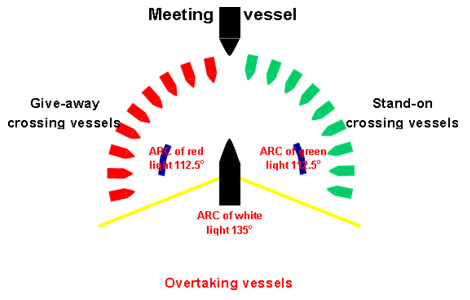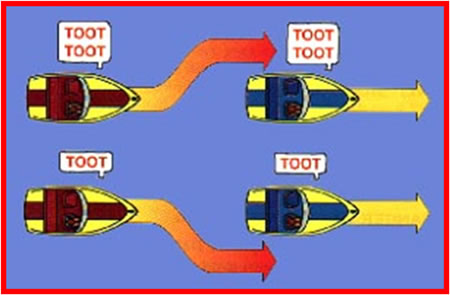|
||
|
|
Yes! Believe It Or Not, Our Waterways Do Have Rules Of The Road!By Tom Nunes Could you imagine, given the sheer number of cars on the road, if we didn’t have traffic laws? Cars would zoom hither and yon, with absolutely no rhyme or reason. Speed — it would be the autobahn on residential side streets! Well, this happens to be the case in some parts of our country, but by-in-large, people obey the traffic laws. In 2006, there were about 25,100,000 motor vehicles registered in the United States. Injuries reported were 1,710,000 in 5.93 million highway crashes in the United States, of which 43,300 which proved fatal, according to the US Department of Transportation’s National Highway Traffic Safety Administration. That’s about 3 percent of all accidents’ injuries resulting in fatalities In the same year, the Coast Guard shows 12,746,126 state registered boats, 4,967 accidents, and 710 deaths as a result of those accidents. That’s 14 percent of all boating accidents resulting in a death! In Arizona, there were 14 deaths from boating accidents in 2006. In any event, one of the reasons why there were accidents on the water was that people did not follow the Rules of the Road. These Rules (there are thirty-eight Rules and 5 Annexes) were formalized in the Convention on the International Regulations for Preventing Collisions at Sea, 1972. Commonly referred to as the COLREGS or the Rules, these Rules, especially the Inland rules, have been in effect (for all Inland waterways) since 1983. Navigation Rules For Dummies Here is a crash course on the Rules. The Coast Guard Auxiliary cannot stress enough the need for ALL boaters to attend a safe-boating course, and to take whatever additional educational courses are required for all boaters to properly understand the meaning and intent of the Rules of the Road. By the way, in 2006, 70 percent of the fatalities occurred with operators who had had no boating-safety education. As a recreational boater, you are responsible for your actions. For those boaters who have RADAR on their vessels, you too have a higher standard, when it comes to collisions at sea, since RADAR is considered a “collision-avoidance tool” (Rule 7), which should be monitored at all times. By the way, no one has the right of way on the water! Basic Rules Rule 5: All vessels are required to have a look-out, on duty at all times, listening and looking, to make “a full appraisal of the situation and of the risk of collision.” The excuse “everyone was down below while we were making way” just doesn’t work. Rule 6: A vessel should travel at a safe speed for existing conditions. The overriding condition is to have the ability to “take proper and effective action to avoid collision and be stopped within a distance appropriate to the prevailing circumstances and conditions.” Rule 8: (“Action to Avoid Collision”) tells us that you must take early and decisive actions to avoid a collision. Decisive actions are defined as “Any alteration of course and/or speed to avoid collision shall, if the circumstances of the case admit, be large enough to be readily apparent to another vessel observing visually or by radar; a succession of small alterations of course and/or speed should be avoided.” And finally, Rule 2 (“Responsibility”) tells us we can throw out the book, should we need too, only as a last result, and only to avoid a collision. However, Rule 2 first states clearly that both vessels must comply with all provisions of the Rules, and even if you have to dismiss the rules in order to avoid a collision, you will still be held responsible for failure to abide by the rules (early and decisive actions) in the first place. Summary: Look, listen, analyze, and make changes to your course and speed that are overt and noticeable to avoid a collision at sea! And if you do have a collision, you are obligated to assist everyone unless the safety of your crew and /or passengers or your vessel is in danger! Danger Zone That being said, all boaters must understand their vessel’s danger zone. It is the area represented by the danger zone, which is at the heart of several of the most important rules.
At night, your vessel is required to show specific colored lights in specified areas on your boat (read on for more info). In the diagram above, you will notice your vessel is represented by the color lights. If you think about it, your boat is like a traffic light, with red and green lights. These lights signify to another vessel whether they can proceed or not. Any vessel which is dead ahead to 112.5° off the starboard (right side) will always see a green light. And, we all know a green light means go. So, whether its daylight or night time, any vessel who would normally see your green light, ALWAYS has the right of way. They are supposed to maintain course and speed, and your vessel is to slow down or change course so the other boat can pass safely in front of, or behind your vessel. The opposite is in effect, should a vessel be sitting to the port (or left) of your bow. Then you have the right of way, and must maintain your course and speed. In all circumstances, be it a head-on (or nearly head-on) meeting, a crossing situation (either from port or starboard) or an overtaking situation, the vessel that wishes to cross or overtake needs to inform the other vessel of its intent. Sound Signals On the land, we use turn signals. On the water, we use sound signals. Rule 34 Inland stipulates that vessels — …shall indicate that maneuver by the following signals on her whistle: one short blast to mean “I intend to leave you on my port side”; two short blasts to mean “I intend to leave you on my starboard side”; and three short blasts to mean “I am operating astern propulsion”. (ii) Upon hearing the one or two blast signals of the other shall, if in agreement, sound the same whistle signal and take the steps necessary to affect a safe passing. If, however, from any cause, the vessel doubts the safety of the proposed maneuver, she shall sound the danger signal…
The Danger Signal is five (5) short blasts. It is used when a danger condition exists or a vessel operator is confused by a situation, and needs all parties to focus. There are two other sound signals that you should be made aware of, astern propulsion and a vessel “nearing a bend or an area of a channel or fairway where other vessels may be obscured by an intervening obstruction” or when leaving a dock or berth. The signal for astern propulsion is three short blasts. The signal used to warn other vessels when nearing a bend or leaving a berth is one long blast. Now you know why, when a large vessel, like a fishing boat or a cruise ship begins to leave port, it gives one long blast, and then three short blasts from its whistle. Education This article in and of itself cannot provide you with all the knowledge you need for safely using Arizona’s waterways. Start your boating education now by taking a Coast Guard Auxiliary, U.S. Power Squadron, or Arizona Game & Fish boating-safety course. The United States Coast Guard Auxiliary offers a wide range of boating courses for all ages and levels of boating knowledge. You can contact the Auxiliary either on the Web (http://www.cgaux.org) or by calling (602) 490-8076.
|
|
 October
2007
October
2007
